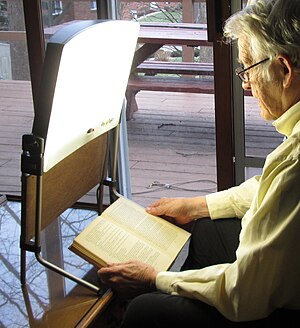Seasonal affective disorder
| Seasonal affective disorder | |
|---|---|
 |
|
| Bright light therapy is a common treatment for seasonal affective disorder and for circadian rhythm sleep disorders. | |
| Classification and external resources | |
| Specialty | psychiatry |
| ICD-10 | F33 |
| MedlinePlus | 001532 |
| Patient UK | Seasonal affective disorder |
Seasonal affective disorder (SAD), also known as winter depression, winter blues, summer depression or seasonal depression, is a mood disorder subset in which people who have normal mental health throughout most of the year experience depressive symptoms at the same time each year, most commonly in the winter.
In the Diagnostic and Statistical Manual of Mental Disorders DSM-IV and DSM-5, its status was changed. It is no longer classified as a unique mood disorder but is now a specifier called with seasonal pattern for recurrent major depressive disorder that occurs at a specific time of the year and fully remits otherwise. Although experts were initially skeptical, this condition is now recognized as a common disorder. SAD's prevalence in the U.S. ranges from 1.4% in Florida to 9.9% in Alaska.
The U.S. National Library of Medicine notes that "some people experience a serious mood change when the seasons change. They may sleep too much, have little energy, and may also feel depressed. Though symptoms can be severe, they usually clear up." The condition in the summer can include heightened anxiety.
SAD was formally described and named in 1984 by Norman E. Rosenthal and colleagues at the National Institute of Mental Health.
There are many treatments for classic (winter-based) seasonal affective disorder.
SAD is a type of major depressive disorder, and sufferers may exhibit any of the associated symptoms, such as feelings of hopelessness and worthlessness, thoughts of suicide, loss of interest in activities, withdrawal from social interaction, sleep and appetite problems, difficulty with concentration and decisions, decreased sex drive, a lack of energy, or agitation. Symptoms of winter SAD often include oversleeping or difficulty waking up in the morning, nausea, and a tendency to over eat, often with a craving for carbohydrates, which leads to weight gain. SAD is typically associated with winter depression, but springtime lethargy or other seasonal mood patterns are not uncommon. Although each individual case is different, in contrast to winter SAD, people who experience spring and summer depression may be more likely to show symptoms such as insomnia, decreased appetite and weight loss, and agitation or anxiety.
...
Wikipedia
